|
It's a sunny day in the American small town of Bradenville. Costume jewellery salesman Harper checks into a hotel and banters cheerfully with the desk clerk, and almost as an afterthought asks if two rookie salesmen to whom he has been instructed to show the ropes could be roomed next to him. Chapman and Dill, the two men in question, are at that very moment approaching the town by train, and as Dill wrestles with travel sickness, Chapman gives sweets to the child of an Amish family who are seated nearby. In the town itself, bank manager Harry Reeves is transfixed by the beauty of female customer Linda Sherman, while librarian Elsie Braden worriedly studies a letter from the bank outlining the likely consequences of her present financial woes. Copper mine superintendent Shelley Martin, meanwhile, drives up just in time to help break up a fight between his young son Stevie and his best friend Georgie, one that kicked off for reasons that Stevie is reluctant to discuss. And while his wife Emily gallivants at the country club with another man, Shelley's partner Boyd Fairchild drunkenly looks for reasons to hold his marriage together. What, we wonder, do all of these people have in common?
A loaded early hint of the real reason that Harper and his colleagues have come to this small town is provided when Harper looks out of his hotel room and observes the departure of the town's two highway patrol officers. In terms of storytelling economy this is quietly superb. Not a word is spoken and there's no exaggerated expression to clue us into Harper's intentions, it's all down to the way actor Stephen McNally calmly observes the two men and the subtly ominous notes of Hugo Friedhofer's score. In the very next scene Dill enters the bank, stands at a table and starts quietly making notes about everything he sees. By the time the three men start openly discussing their plan to rob the bank, we've already worked out that this is why they are here. Of course, we never really bought the suggestion that Chapman and Dill could be trainee salesmen, and were probably never meant to. Chapman seems a little too old and unfriendly, and Dill is played by a young Lee Marvin, and no-one is going to buy costume jewellery from him.
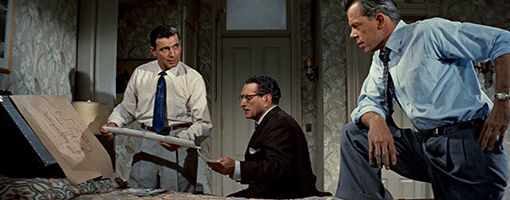
It's a heist movie, then. Well, yes and no. Rather than stay with the robbers in the Rififi manner, the film then returns to various personal dramas of which we have been given a brief glimpse and affords each of them the same amount of screen time as the unfolding plans to rob the town's bank. And all are intriguing in their own way, bite-sized snippets of behind-closed-doors small town life that are each set to be impacted by, or inadvertently become part of, the robbery that we know is set to take place. Quite how each of them will be affected is part of the film's considerable grip – the obvious supposition is that they'll all be in the bank when the robbery goes down, but nothing about how the narrative unfolds suggests that the obvious is on the cards. There's an economical tightness to every scene here, and seemingly every piece of character detail appears to have secondary purpose and foreshadow events that will later take place. Thus when Shelley sits down to talk about his war service with Stevie, particularly in relation to that of Georgie's decorated father, you can be sure this is about more than Shelley's relationship with his young son.
That the stories start to overlap and interconnect is almost inevitable given the film's small town setting. This is signalled from the start by a very neatly orchestrated opening sequence, in which Harper steps off a bus, is nearly run over by an agitated Emily on her way to the country club, passes the window of a bank just as Harry opens the blind, and eyes up Linda as she leaves the hotel. The connections continue when Harry watches the desperate Elsie surreptitiously steal a handbag that has been left at the library by a careless customer, then exits the building just as the fight breaks out between Stevie and Georgie, mere seconds before Shelley's timely arrival. So understated are these connective moments that they could almost pass you by on a first viewing, but they subtly draw a thread through the disparate stories that interweaves and tightens as the story progresses. Even when they are the result of planning rather than chance they don't appear that way, at least in the first half. When Harper rolls up at an Amish farm looking to use a phone because his car has broken down, for example, we could almost take this for the accidental encounter it purports to be – after all, we've not seen Chapman say anything to Harper about what he learned from the train guard about the Amish people and their rejection of modern technology. Which doesn't mean it didn't happen, of course.
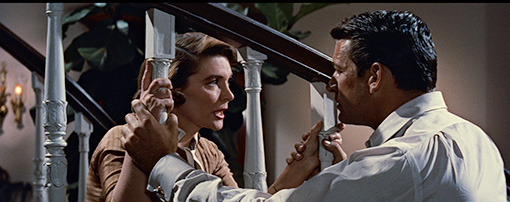
The manner in which the stories interconnect has its share of surprises, and frequently seems engineered to flesh out the characters and involve us more in their individual plights. In the process it paints a picture of a town in which many of those set to become victims of a crime are also guilty of their own moral transgressions, whether they be theft, adultery or voyeuristic stalking. All of this textures the drama and prompts a deeper emotional connection to people who in most such films would be little more than faceless background characters to be shocked and menaced when the moment is right. By the time the robbery itself gets under way, our investment in them is strong enough for us to be genuinely concerned for their safety. And hanging over every scene is that ominous title, one that assures us in no uncertain terms that this particular hold-up is not destined to play out as smoothly as planned.
Richard Fleischer is one of those unsung directors whose work cineastes and other filmmakers admire, but whose name rarely headlines posters or video cases of the films he directed. Perhaps it's because it's actually hard to pin down a specific Fleischer style in the way we might do with Hitchcock or Orson Welles – it would certainly be tough to find thematic and stylistic connections between his taut 1949 noir crime drama Trapped and the science fiction spectacle Fantastic Voyage or the musical fantasy of Doctor Dolittle. But in the course of his career he directed a sizeable collection of minor classics, including Armoured Car Robbery (1950), The Narrow Margin (1952), The Vikings (1958), Compulsion (1959), The Boston Strangler (1968), 10 Rillington Place (1971) and Soylent Green (1973). He also handled the American sequences of the 1970 recreation of the Japanese attack on Pearl Harbour, Tora! Tora! Tora!. I'd be happy enough with that lot under my belt.
Violent Saturday was made at the tail end of Fleischer's productive noir thriller period and immediately after he was hired by Disney to direct a film adaptation of Jules Verne's 20,000 Leagues Under the Sea. And it's an absolute cracker, a grippingly structured multi-stranded melodrama that, over the course of ninety waste-free minutes, evolves into a riveting, precision-tooled and noir-tinged heist thriller. And despite a cast that features a mix of established stars, character actors and up-and-coming talent – including Victor Mature, Stephen McNally, Virginia Leith, J. Carrol Naish, Sylvia Sidney and Ernest Borgnine, all Fox contract players and all impressive here – this is essentially an ensemble piece, with no one character standing out as the lead until the tense and surprisingly brutal climactic stand-off.
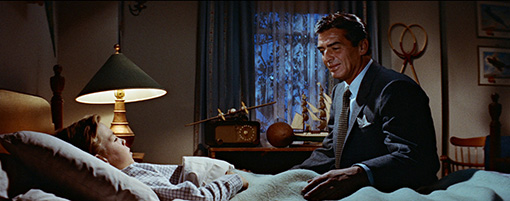
The economy of Fleischer's direction includes a purposeful use of the CinemaScope format, moving the camera with and around characters and positioning them within the frame in ways that highlight their feelings or intentions without stating them out loud. He's served well here by Charles D. Clarke's sometimes striking scope compositions (check out the breathtaking early wide shot of the train on which Chapman and Dill are travelling, where the approaching locomotive is framed by mountains, an industrial chimney and the trail of smoke that stretches over the landscape like the top bar of a goal mouth) something that was doubtless decimated by the cropped prints that we can presume were once screened on TV.
As the narrative concludes, some stories are tidily resolved while others are left for us to speculate on, and not all are destined to have happy endings. The film has also earned itself a place in history for its sympathetic and even respectful presentation of the Amish farming family and their way of life, which could well be a first for American mainstream cinema, having the jump on Witness by a full thirty years. Of course, like almost every other element in this remarkable film, their role in the narrative serves a dual purpose (you should have no trouble decoding the subtext on this one), and cult movie fans will get a particular thrill from the casting of a commendably restrained Ernest Borgnine as the Amish patriarch, a role he was to somewhat more colourfully repeat in Wes Craven's underrated 1981 Deadly Blessing.
The contrast is, at times, just a little strong, with super-solid black levels achieved at the expense of some shadow detail. And that's the only criticism I have of this otherwise exemplary HD transfer, which honours the film's original 2.55:1 aspect ratio. The picture is crisp and clean, with rich and often vibrant colour, and the excellent level of detail reminds us just how good a 35mm CinemaScope image could look, even when the budget wasn't in the millions. The picture really pops on the daylight exteriors, but still looks terrific in the carefully lit interiors and night-time imagery.
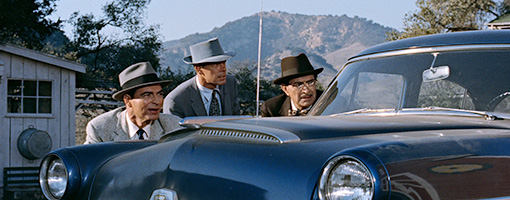
There are two soundtracks on offer here, PCM Linear 2.0 stereo and DTS-HD Master Audio 4.0 surround. Both are apparently true to the original Western Electric Recording 4-track "Stereoscopic" magnetic print soundtrack and are equally clean and clear, with solid reproduction of dialogue and Hugo Friedhofer's tone-setting and sometimes full-blooded score. No distracting background hiss or damage was evident, and the dynamic range is better than you would expect for a film of this vintage.
One thing that may throw you on both soundtracks (it did me at first) is the breadth of the stereo separation in places. When the film screened in cinemas with its stereo soundtrack, the speakers would have been located behind the screen, much as the front-located speakers are today. Thus when characters talk at either edge of the screen – particularly on the right, for some reason – their voices move exclusively to the right-hand speaker. Now in the cinema this speaker would be located almost directly behind where the character in question was delivering his or her lines, but on my home cinema system the front stereo speakers are sited several feet from the TV screen. Thus when a character moves to the edge of the screen to speak, their voice hops off the screen and into the corner of the room. The closer your front speakers are located to your viewing screen, the less of an issue this is likely to be.
Optional SDH subtitles are also available.
Richard Fleischer, Storyteller (20:36)
The Exorcist, The French Connection and Killer Joe director William Friedkin talks about one of his favourite films by a director he clearly admires a great deal. It's an engaging chat in which the filmmaker focuses on specific aspects of what makes the particular film so special, including the subtle performances, the telling use of CinemaScope, the use of frames within frames, the moralistic undertones (which he attributes to producer Richard Zanuck) and the resonance of the subplots.
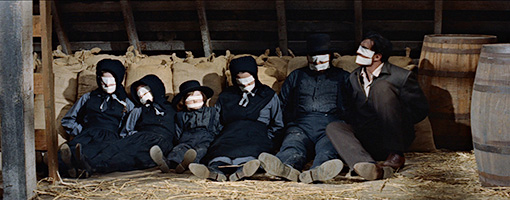
Mélodrame Policier (28:07)
French writer-director Nicolas Saada delivers an audio essay on the film illustrated by clips, stills and posters. It's a detailed and captivating examination that compares the film directly to David Cronenberg's A History of Violence and explores the use of the scope frame, the painterly nature of some compositions, the tradition of American ensemble film storytelling, the symbolic nature of the mountain range setting, and a good deal more, sometimes in considerable detail and with specifically selected examples. He intriguingly describes the film as being "Fuller intruding on Minnelli, or Minnelli being disrupted by Fuller," and at one point claims that this is a rare case of the original title being better than the French title, a bold statement that I'd suggest deserves an essay of its own. This is in French with English subtitles.
Booklet
The centrepiece of this typically fine Eureka booklet is an essay by Adam Batty on the film and its director. But there's more. Also on board is a reproduction of the film's campaign book, a fascinating document full of advice on how to promote the film and what looks like clippings from newspapers, though I'm guessing these are actually pre-prepared stories designed to be sent to the local press. They include pieces on individual actors, the difficulty of obtaining authentic Amish clothing, and how to tie the release in with the golfing season. Great stuff. As ever, there are also credits for the film, stills, and advice on correct viewing.
I've seen a few retrospective reviews of Violent Saturday that I'd probably describe as cautiously enthusiastic, ones that express surprise at how much the writer enjoyed the film or how multiple viewings have seen it grow on them. I experienced no such hesitation, and fell in love with it from its opening scene. A terrific showcase for the too-often undervalued talents of its gifted director, it is most impressively presented on Eureka's welcome dual format release. I've only one question – why was this not a Masters of Cinema title? Either way, this comes highly recommended.
|